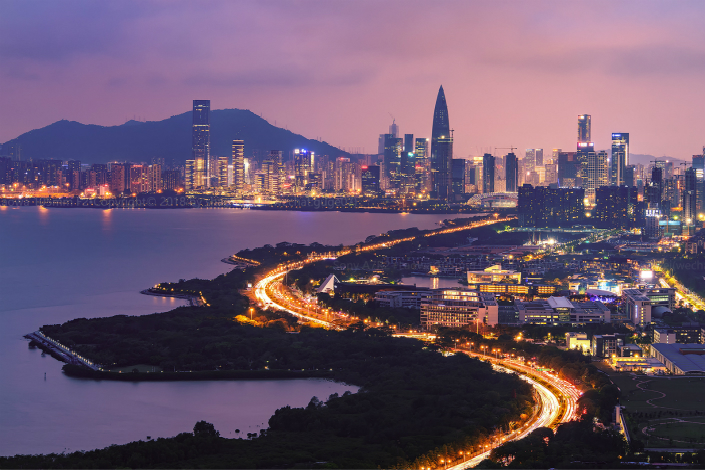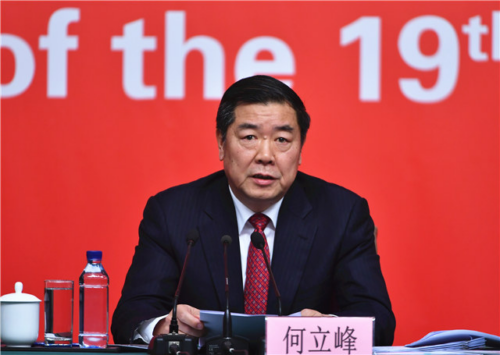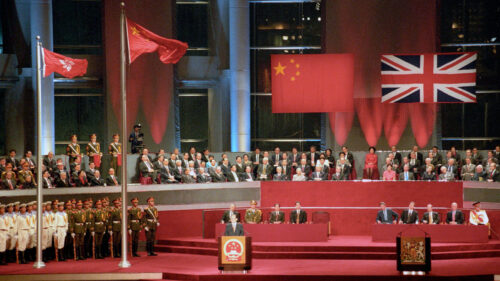Hong Kong might survive the protests, but will the Greater Bay Area?

The Greater Bay Area surrounding Hong Kong is China’s richest region, home to mega-cities reinventing themselves as tech hubs. This is where the protests in Hong Kong have become more threatening to China’s economic priorities.

As the world stands transfixed by scenes of clashes between police and protesters in Hong Kong, it can seem incongruous to read about Hangzhou-based Alibaba, the world’s biggest ecommerce company, pushing ahead with a mammoth IPO in this city. Worth as much as $15 billion, the listing, which is being hawked in a roadshow to institutional and retail investors, will likely be several times oversubscribed. How can the company founded by Jack Ma not care that the streets around Exchange Square are lined with bricks and petrol bombs? How can it be proceeding with business as usual amid the chaos?
The callous yet simple answer is that Hong Kong is a financial center that does not need safe streets to process tens of billions of dollars flowing daily through its stock exchange, its banks, its hedge and mutual funds, and its insurance companies.
It would not be untrue, moreover, to say that as far as the central government is concerned, Hong Kong’s primary value to the country is as an offshore financial center with a fully convertible currency. Beijing stopped caring long ago about whether Hong Kong can demonstrate the benefits of adopting liberal-democratic values from the West. The restraint it has shown in not sending troops to quell the protests is grounded in realpolitik. If the PLA marches in, and the U.S. pulls the plug on Hong Kong’s special trading status, the fund flows will dry up.
This is probably a stronger reason why President Xí Jìnpíng 习近平 took time out from his busy schedule in Brasilia last week to issue a statement about the protests, rather than because the Chinese University of Hong Kong campus had become a battlefield. He must surely be concerned about the protests affecting Hong Kong’s role as a conduit for more than 70 percent of all financial flows between China and the world.
For now, it seems he need not worry that much. As Bloomberg reports, “Multinationals are still pouring cash into China.” So, too, is Bridgewater Associates, the world’s biggest hedge fund, run by Ray Dalio. And Alibaba has the investment community fired up like nothing the city’s trading community has seen in years. The protesters may be able to block highways, but they cannot block buy and sell orders passing through Hong Kong’s digital infrastructure.
Plenty of commentators have already pointed this out. What is being overlooked amid the clatter, however, is the other vital role played by Hong Kong in China’s business plans: as a key driver of growth for the neighboring region, known as the Greater Bay Area (粤港澳大湾区 yuè gǎng’ào dàwān qū). This is likely a more serious concern for the country’s leadership. As economic data continues to pile up showing a marked slowdown across China, Premier Lǐ Kèqiáng 李克强 is clearly getting more concerned about finding ways to fire up the engines. Hong Kong is one of those. Or, at least, it was supposed to be.
The Greater Bay Area surrounding Hong Kong doesn’t get as much media attention as Beijing and Shanghai, but it should. It is China’s richest region, home to not only Hong Kong, but two similarly sized economic hubs: the mega-cities of Guangzhou and Shenzhen, both of which are reinventing themselves as tech hubs. Knit together by high-speed trains within a one-hour traffic circle, this is China’s closest approximate to Silicon Valley, only with a financial capital like New York at its center.
Together with manufacturing powerhouses Dongguan and Foshan, plus smaller cities in Zhongshan, Jiangmen, Huizhou, Zhaoqing, and Zhuhai, as well as the gambling hub of Macau, the Greater Bay Area is the world’s 10th-largest economy, bigger than South Korea. By the end of next year, it will likely surpass Canada to take the No. 9 spot, with a combined annual GDP of more than $1.8 trillion.
Whether the GBA, as everyone here calls it, can achieve that goal — or its loftier one of becoming the world’s premier “bay area economy” by the end of 2035 — depends largely on whether Hong Kong can play its assigned role within the masterplan unveiled in February this year.
Protesters realize that the best way to get the government’s attention is to disrupt the financial community. Will the big tech events, such as the Rise conference in June next year, be targeted?
Amid all the jargon about integration and collaboration in the plan, one guiding mission is evident. Guangdong is to lead the way for China in experimenting with new economic reforms, just as it did in 1979, when Shenzhen launched the so-called “Reform and Opening” era under a dynamic official by the name of Xí Zhòngxūn 习仲勋, father of the current president.
Chief of these reforms is getting more companies into the hands of private investors, particularly technology companies. As a provincial government official noted recently at a conference in Guangzhou, Guangdong has 45,000 national-level tech firms. For every Tencent, Ping An, or DJI, based in Shenzhen, there are thousands more waiting to become the region’s next unicorn. All would dearly like to follow the path of Sensetime, the Shenzhen-bred, Hong Kong-based AI startup that is now worth billions.
This is where the protests in Hong Kong have become more threatening to China’s economic priorities, however. Conferences are needed to bring investors and startups together. Although Fintech Week was recently held here successfully, staged at an expo center that is far from downtown, next to the airport, that was before the protesters began specifically targeting the financial district. They now realize that the best way to get the government’s attention is to disrupt the financial community. Will the big tech events, such as the Rise conference (which has already been postponed from next March to March 2021*), be targeted?
More than events are needed to make the GBA plan work. Academic research institutions in Hong Kong have been key conduits of cutting-edge research into Guangdong, and hubs of science and technology exchanges. They are now shut, until further notice. International lawyers, accountants, insurers, and many other professionals from Hong Kong needed to make the GBA plan work are now finding themselves wondering if they should still be here.
More’s the pity, because the GBA is an incredible investment opportunity. Although China as a whole has seen plunging fixed-asset investment levels recently, the GBA’s have been holding up. This is not only due to surging infrastructure buildout — it has the country’s most advanced high-speed railway network under construction — but also because of private-sector participation in the economy, which is higher than the national average. Shanghai’s Yangtze River Delta is burdened with many more state-owned lumbering giants. The Beijing-Tianjin region cannot compare. The Greater Bay Area is the best place in the country, if not the world, to be placing bets on the future at the moment.
Assuming Hong Kong can clean itself up, that is.
Anthony Lawrence is joining The China Project for a December 4 event in New York on the Greater Bay Area. If you would like to follow the Greater Bay Area’s ins and outs more closely, sign up for a free daily newsletter edited by Lawrence at GreaterBayInsight.com.
* We’ve made a correction of an earlier version that misidentified the date of the next Rise.





